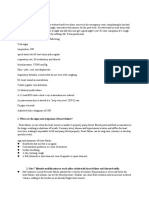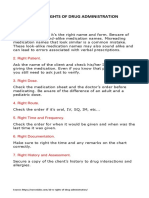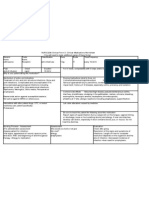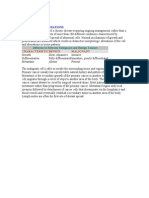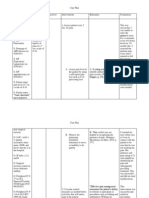STUDENT-Sepsis - Fundamental - Reasoning Fillable-1
STUDENT-Sepsis - Fundamental - Reasoning Fillable-1
Uploaded by
Laura PoultneyCopyright:
Available Formats
STUDENT-Sepsis - Fundamental - Reasoning Fillable-1
STUDENT-Sepsis - Fundamental - Reasoning Fillable-1
Uploaded by
Laura PoultneyOriginal Title
Copyright
Available Formats
Share this document
Did you find this document useful?
Is this content inappropriate?
Copyright:
Available Formats
STUDENT-Sepsis - Fundamental - Reasoning Fillable-1
STUDENT-Sepsis - Fundamental - Reasoning Fillable-1
Uploaded by
Laura PoultneyCopyright:
Available Formats
Fundamental Reasoning: STUDENT
Sepsis
I. Developing Nurse Thinking by Identifying Clinical Relevance/Significance
History of Present Problem:
Jean Kelly is an 82 year old woman who has been feeling more fatigued for the last three days and has had a fever the
last twenty-four hours. She reports painful, burning sensation when she urinates as well as frequency of urination the last
week. It has been >90 degrees this past week. She usually drinks 2-3 glasses of liquid a day and a cup of tea. Her daughter
became concerned and brought her to the emergency department (ED) when she did not know what day it was. She is
mentally alert with no history of confusion.
Personal/Social History:
Jean lives independently in a senior apartment retirement community. She is widowed and has two daughters who are
active and involved in her life. While taking her bath today, she was unable to get out of the tub and used the help button.
When help arrived, she was able to get to the side of the tub and sit. Upon standing to ambulate she became dizzy and lost
her balance. She didn’t get injured while coming down hard on the toilet seat.
What data from the histories is important & RELEVANT; therefore it has clinical significance to the nurse?
RELEVANT Data from Present Problem: Clinical Significance:
82 y/o female possible UTI
states feeling "more fatigued for the last 3 impaired LOC and mental state
days" risk for infection
fever for 24 hr
burning sensation during urination
confusion
RELEVANT Data from Social History: Clinical Significance:
independently in a senior apartment Did infection occur because she is unable to care for herself? If so
has two daughters who are active in her life
unable to get out of bathtub today than an assisted living facility may be best suited
dizzy and lost balance
Lab/diagnostic Results:
Basic Metabolic Panel (BMP): Current: High/Low/WNL?
Sodium (135-145 mEq/L) 140 WNL
Potassium (3.5-5.0 mEq/L) 3.8 WNL
Glucose (70-110 mg/dL) 184 HIGH
Creatinine (0.6-1.2 mg/dL) 1.5 HIGH
Complete Blood Count (CBC): Current: High/Low/WNL?
WBC (4.5-11.0 mm 3) 13.2 HIGH
Hgb (12-16 g/dL) 14.4 WNL
Platelets(150-450x 103/µl) 246 WNL
Neutrophil % (42-72) 93 HIGH
What lab results are RELEVANT that must be recognized as clinically significant to the nurse?
RELEVANT Lab(s): Clinical Significance:
WB increased means infection
neutrophils
glucose hyperglycemia
creatinine kidney failure
© 2013 Keith Rischer/www.KeithRN.com
II. Nurse Collected Clinical Data:
Current VS: WILDA Pain Scale (5th VS)
T: 101.8 (oral) Words: Ache
P: 110 (regular) Intensity: 5/10
R: 24 Location: Right flank
BP: 102/50 Duration: Continuous/ongoing
O2 sat: 98% Aggreviate: Nothing
room air Alleviate: Nothing
The nurse recognizes the need to validate his/her concern of fluid volume deficit and performs a set of
orthostatic VS and obtains the following:
Position: HR: BP:
Lying 110 102/50
Standing 132 92/42
What VS data is RELEVANT that must be recognized as clinically significant?
RELEVANT VS Data: Clinical Significance:
lying HR: 110, BP: 102/50 HPO
standing HR: 132, BP: 92/42 Tachycardia
Current Assessment:
GENERAL Resting comfortably, appears in no acute distress
APPEARANCE:
RESP: Breath sounds clear with equal aeration bilaterally, nonlabored respiratory effort
CARDIAC: Pink, warm & dry, no edema, heart sounds regular-S1S2, pulses strong, equal with
palpation at radial/pedal/post-tibial landmarks
NEURO: Alert and oriented x2-is not consistently oriented to date and place, c/o dizziness when she
sits up
GI: Abdomen soft/nontender, bowel sounds audible per auscultation in all four quadrants
GU: Admits to dysuria and frequency of urination the past week, right flank tenderness to gentle
palpation
SKIN: Skin integrity intact
What assessment data is RELEVANT that must be recognized as clinically significant?
RELEVANT Assessment Data: Clinical Significance:
A/o x 2 UTI symptoms
dysuria
urination 1x a week Infection
right flank tenderness when
palpating
© 2013 Keith Rischer/www.KeithRN.com
III. Developing Nurse Thinking by APPLICATION of the Applied Sciences
Fluid & Electrolytes:
Lab: Normal Value: Clinical Significance: Nursing Assessments/Interventions Required:
WBC possible infection UTI
Infection in body
Value: Critical value:
14.2
Lab: Normal Value: Clinical Significance: Nursing Assessments/Interventions Required:
Neutrophils possible infection make sure to use sterile process with patient to
not further cause infection
Value: Critical value:
no catheters or make sure they are clean
93%
Pharmacology:
Home Med: Classification: Mechanism of Action: Nursing Considerations:
Allopurinol
antigout inhibits uric acid production and monitor for wheezing, dyspnea,
(Zyloprim)
xanthine oxidase and tightness in chest
Pioglitazone
antidiabetic decreases insulin resistance eat with meal, check blood sugars,
(Actos)
don't skip dose
Simvastatin
(Zocor) antiviral inhibits HCV NS3/4A protease Daily labs
Metoprolol
Beta blocker inhibits beta 1 receptors blurred vision, HPO, bradcardia, n/v
(Lopressor)
Lisinopril
(Prinivil) ACE inhibitor inhibits angiotensin HPO, do not take during
pregnancy, swollen face, HA
© 2013 Keith Rischer/www.KeithRN.com
Medication Dosage Calculation:
Medication/Dose: Mechanism of Action: Volume/time frame to Nursing Assessment/Considerations:
Safely Administer:
Ceftriaxone cephalosporin take prescription exactly as ordered
1g IVPB
Hourly rate IVPB: take pt medical hx of any allergies
to penicillin
Normal Range: 30
(high/low/avg?)
IV. Developing Nurse Thinking by Identifying Clinical RELATIONSHIPS
1. What is the RELATIONSHIP of the past medical history and current medications?
(Which medication treats which condition? Draw lines to connect)
Past Medical History(PMH): Home Meds:
Diabetes type II 1.Allopurinol 100 mg bid
4 Gout
Hyperlipidemia 2.Colchicine 0.6 mg prn
5 IDK
HTN 3.ASA 81 mg daily
6,7,8
Gout 4.Pioglitazone (Actos) 15 mg daily
1,2 DM
5.Simvastatin 20 mg daily
6.Metoprolol 25 mg bid
HTN
7.Lisinopril 10 mg daily
8. Furosemide (Lasix) 20 mg daily
2. Is there a RELATIONSHIP between any disease in PMH that may have contributed to the development of the
current problem? (Which disease likely developed FIRST that then began a “domino effect”?)
PMH: What Came FIRST:
Diabetes type II
HTN first, then DM, hyperlipidemia, gout
Hyperlipidemia
HTN What Then Followed:
Gout
3. Is there a RELATIONSHIP of a problem in your patient’s PMH that contributed to the current primary problem?
Primary Contributing Problem: Pathophysiology Cause/Relationship to Present Problem:
DM increased urination
82 y/o increased risk for infection, mental state, ability to care for
herself
4. What is the RELATIONSHIP between the primary care provider’s orders and primary problem?
Care Provider Orders: How it Will Resolve Primary Problem/Nursing Priority:
Establish peripheral IV
a patent IV is a priority
0.9% NS 1000 mL IV bolus fluid balance
© 2013 Keith Rischer/www.KeithRN.com
fever and pain reducer
Acetaminophen 650 mg po
Ab to treat infection
Ceftriaxone 1g IVPB…after blood/urine
cultures obtained
Morphine 2 mg IV push every 2 hours pain mgmt
prn-pain
V. Developing Nurse Thinking by Identifying Clinical PRIORITIES
5. What is the primary problem that your patient is most likely presenting with?
UTI that has not been treated resulting in altered LOC
6. What nursing priority will guide your plan of care?
treat infection and pain, risk for sepsis,
7. What interventions will you initiate based on this priority?
Nursing Interventions: Need a patent IV
Fluids-NS Rationale: Expected Outcome:
Admin Acetaminophin
admin Ceftriaxone
admin morphine
Need a patent IV fluids! IV needed for tx
Fluids-NS fluid balance after
Admin Acetaminophin fever and pain reducer polyuria
admin Ceftriaxone Ab tx for infection reduce body temp
admin morphine pain mgmt no further
complication by
infection
VI. Caring & the “Art” of Nursing
9. What is the patient likely experiencing/feeling right now in this situation?
Pain, which will be alleviated with morphine, confused mental state and not sure why she is there,
which will get resolved once infection is under control
10. What can I do to engage myself with this patient’s experience, and show that he/she matters to me as a person?
Be there for the pt even if her LOC is altered, listen to her needs
© 2013 Keith Rischer/www.KeithRN.com
You might also like
- Titan TrainingDocument4 pagesTitan Trainingantoniozannini80% (10)
- AKICaseStudy (Exam4)Document4 pagesAKICaseStudy (Exam4)Erica MeyersNo ratings yet
- Clinical Log Term II PDFDocument9 pagesClinical Log Term II PDFPriscilla S100% (1)
- Case Study 2Document7 pagesCase Study 2desdav100% (1)
- Ba GastrectomyDocument10 pagesBa GastrectomyHope3750% (2)
- Concept Map Worksheet Mary Richards Heart Failure Jasgou1752Document3 pagesConcept Map Worksheet Mary Richards Heart Failure Jasgou1752Jasmyn Rose100% (1)
- Transition Care PlanDocument5 pagesTransition Care PlangyanendraNo ratings yet
- Physical Assessment Write-UpDocument10 pagesPhysical Assessment Write-UpkathypinzonNo ratings yet
- VSim SARAH LIN For Nursing - Health Assessment POST QUIZDocument5 pagesVSim SARAH LIN For Nursing - Health Assessment POST QUIZWen RodsaNo ratings yet
- Acute PainDocument1 pageAcute Painnursing concept mapsNo ratings yet
- Transitional Care Case Study-Pulling It All TogetherDocument13 pagesTransitional Care Case Study-Pulling It All TogethermatthewNo ratings yet
- Amlodipine (Anti-Hypertensive, Calcium Channel Blocker)Document1 pageAmlodipine (Anti-Hypertensive, Calcium Channel Blocker)Danielle Marie SamblacenoNo ratings yet
- Individual Inventory Form: Personal ProfileDocument2 pagesIndividual Inventory Form: Personal ProfileArthur Capawing100% (2)
- Care Plan Number 2Document5 pagesCare Plan Number 2Teddy mc Bones100% (1)
- STUDENT Sepsis Rapid ReasoningDocument6 pagesSTUDENT Sepsis Rapid Reasoningghodghod123No ratings yet
- Anemia-Careplan For AdultDocument29 pagesAnemia-Careplan For AdultdjbhetaNo ratings yet
- Med-Surg Care PlanDocument13 pagesMed-Surg Care Planapi-520453750No ratings yet
- Sample: Duquesne University School of Nursing Care Map TemplateDocument6 pagesSample: Duquesne University School of Nursing Care Map TemplateDevin Nikole BlattnerNo ratings yet
- What Are The Signs and Symptoms of Heart Failure?Document4 pagesWhat Are The Signs and Symptoms of Heart Failure?Lara TechiesNo ratings yet
- Case AnalysisDocument25 pagesCase AnalysisGerly LagutingNo ratings yet
- NCM 106 - Case Analysis - Nursing Care Plan of Heart FailureDocument2 pagesNCM 106 - Case Analysis - Nursing Care Plan of Heart FailureMarisol Jane JomayaNo ratings yet
- CHF Cardiomegaly Volume OverloadDocument1 pageCHF Cardiomegaly Volume Overloadnursing concept mapsNo ratings yet
- Waiters Rhabdomyolysis PDFDocument1 pageWaiters Rhabdomyolysis PDFTommieNo ratings yet
- Last CareplanDocument22 pagesLast CareplanNneka Adaeze AnyanwuNo ratings yet
- Alcohol Withdrawal Care PlanDocument1 pageAlcohol Withdrawal Care PlanVanessaMUellerNo ratings yet
- Nursing Care Plan EportfolioDocument14 pagesNursing Care Plan Eportfolioapi-279212367No ratings yet
- Medication - ALT-Template Polythene GlycolDocument1 pageMedication - ALT-Template Polythene GlycolNancyAmissahNo ratings yet
- Nursing Care PlanDocument5 pagesNursing Care PlanDeo FactuarNo ratings yet
- Head To Toe Assessment (Elder)Document2 pagesHead To Toe Assessment (Elder)ZnarfNo ratings yet
- Nursing Care Plan - MergedDocument13 pagesNursing Care Plan - MergedJuls Flares SycaycoNo ratings yet
- Fluid Volume Deficit Nursing Care PlanDocument4 pagesFluid Volume Deficit Nursing Care PlanTipey SegismundoNo ratings yet
- CarafateDocument1 pageCarafateAdrianne BazoNo ratings yet
- Drug Study Drug Name Classificatio N Dosage/ Prepatarion Indication Contraindication Side Effects Nursing ResponsibilitiesDocument4 pagesDrug Study Drug Name Classificatio N Dosage/ Prepatarion Indication Contraindication Side Effects Nursing ResponsibilitiesTheresa AbrilloNo ratings yet
- Surgery Observation PaperDocument3 pagesSurgery Observation Paperapi-546690876No ratings yet
- The Ten Rights of Drug AdministrationDocument2 pagesThe Ten Rights of Drug AdministrationMike CalipayanNo ratings yet
- Concept Map Due 04Document9 pagesConcept Map Due 04api-545711468No ratings yet
- DX Infective Endocarditis PDFDocument7 pagesDX Infective Endocarditis PDFSherree HayesNo ratings yet
- Pharmacotherapy II: HypertensionDocument125 pagesPharmacotherapy II: HypertensionEn Oh O EndNo ratings yet
- Ceftriaxone RocephinDocument1 pageCeftriaxone RocephinENo ratings yet
- Head To Toe Physical AssessmentDocument6 pagesHead To Toe Physical AssessmentGarrett BatangNo ratings yet
- Liver Cirrhosis: Etiology Pathogenesis Clinical Features Management PrognosisDocument35 pagesLiver Cirrhosis: Etiology Pathogenesis Clinical Features Management PrognosisMohd Johari Mohd ShafuwanNo ratings yet
- Cancer NursingDocument53 pagesCancer Nursingfairwoods100% (1)
- Diabetes MellitusDocument26 pagesDiabetes MellitusOndari gisemba OSINDENo ratings yet
- The Perioperative NursingDocument11 pagesThe Perioperative NursingDa BondadNo ratings yet
- Pain Care PlanDocument18 pagesPain Care Planjordanw0613No ratings yet
- PQRSTDocument64 pagesPQRSTiduhilagNo ratings yet
- Kardex Written ReportDocument3 pagesKardex Written ReportCommunity BNo ratings yet
- Anes Drugs TableDocument20 pagesAnes Drugs TableKathleen Grace ManiagoNo ratings yet
- SBAR Report To Physician About A Critical SitutionDocument3 pagesSBAR Report To Physician About A Critical SitutionRandolph DjanieNo ratings yet
- Complete Normal Physical Exam PDFDocument3 pagesComplete Normal Physical Exam PDFFrancisco Casio MataNo ratings yet
- Week 10 Drug Card - Hydrochlorothiazide (HCTZ)Document2 pagesWeek 10 Drug Card - Hydrochlorothiazide (HCTZ)RCurry09No ratings yet
- Ineffective Coping - Nursing Diagnosis & Care Plan - NurseslabsDocument13 pagesIneffective Coping - Nursing Diagnosis & Care Plan - NurseslabsLester MooreNo ratings yet
- Pedia - History Taking and Physical Exam - PGI Leira BarbosaDocument6 pagesPedia - History Taking and Physical Exam - PGI Leira BarbosaLeira BarbosaNo ratings yet
- ATI Med Template Vitamin DDocument1 pageATI Med Template Vitamin DHeather MoralesNo ratings yet
- Concept Map SepsisDocument4 pagesConcept Map SepsisSavanna ChambersNo ratings yet
- 2nd Case Scenario BronchitisDocument5 pages2nd Case Scenario BronchitisKasandra Dawn Moquia BerisoNo ratings yet
- Decreased Cardiac OutputDocument5 pagesDecreased Cardiac Outputshuang81No ratings yet
- Physical Assessment 1. General InspectionDocument3 pagesPhysical Assessment 1. General InspectionRijelNo ratings yet
- Sheila Dalton Case Study-1Document4 pagesSheila Dalton Case Study-1tommy0% (7)
- Ventricular Septal Defect, A Simple Guide To The Condition, Treatment And Related ConditionsFrom EverandVentricular Septal Defect, A Simple Guide To The Condition, Treatment And Related ConditionsNo ratings yet
- A Simple Guide to Pseudohypoparathyroidism, Diagnosis, Treatment and Related ConditionsFrom EverandA Simple Guide to Pseudohypoparathyroidism, Diagnosis, Treatment and Related ConditionsNo ratings yet
- Testosterone Week: How I Doubled My Testosterone Levels Naturally and You Can TooDocument18 pagesTestosterone Week: How I Doubled My Testosterone Levels Naturally and You Can Too666Fenriz666No ratings yet
- Module Week 1 Tle and EspDocument17 pagesModule Week 1 Tle and EspAlexa Mae Sanchez100% (1)
- Criminal Case Kelompok 6Document3 pagesCriminal Case Kelompok 6Desy Martha ShelvyaniNo ratings yet
- Additional Solutions - Chapter 15Document24 pagesAdditional Solutions - Chapter 15maxima0078No ratings yet
- Connect SEP2021 WebDocument64 pagesConnect SEP2021 WebRoremNo ratings yet
- NUR11O1 Integrated Human Anatomy and Physiology Department of Biology Institute of Arts and Sciences Far Eastern UniversityDocument5 pagesNUR11O1 Integrated Human Anatomy and Physiology Department of Biology Institute of Arts and Sciences Far Eastern UniversityGeia Marie SilveroNo ratings yet
- Strengthand Conditioningfor Cricket Fielding ANarrative ReviewDocument17 pagesStrengthand Conditioningfor Cricket Fielding ANarrative ReviewsagarNo ratings yet
- Cover CroppingDocument21 pagesCover CroppingSHADOW KHANNo ratings yet
- Analisis Teknik Permainan Gitar Pada Komposisi Gitar Sunburst Karya Andrew YorkDocument7 pagesAnalisis Teknik Permainan Gitar Pada Komposisi Gitar Sunburst Karya Andrew YorkTernakayam SurabayaNo ratings yet
- 2021 Bulldog Invitational Info Packet Day ofDocument8 pages2021 Bulldog Invitational Info Packet Day ofapi-463490665No ratings yet
- Who 2017-244-253Document10 pagesWho 2017-244-253Seba OrtegaNo ratings yet
- M14 Software Process Management Exam Paper Coventry UniversityDocument15 pagesM14 Software Process Management Exam Paper Coventry UniversitySaud Ab AljaloudNo ratings yet
- Logitech M-171 Wireless Optical Mouse: Grand Total 625.00Document1 pageLogitech M-171 Wireless Optical Mouse: Grand Total 625.00rupeshghadiNo ratings yet
- Some Members of Class Xanthophyceae and Euglenophyceae From Soils of Peshawar Valley, Khyber Pukhtoonkhawa, PakistanDocument6 pagesSome Members of Class Xanthophyceae and Euglenophyceae From Soils of Peshawar Valley, Khyber Pukhtoonkhawa, PakistanSamsung S3 MiniNo ratings yet
- 制药工程论坛 关于手动积分指南Document15 pages制药工程论坛 关于手动积分指南66492334No ratings yet
- Powerplant Text 7-12Document148 pagesPowerplant Text 7-12francis verzosaNo ratings yet
- BỘ ĐỀ MINH HỌA TUYỂN SINH LỚP 6 TRƯỜNG THCS CẦU GIẤYDocument25 pagesBỘ ĐỀ MINH HỌA TUYỂN SINH LỚP 6 TRƯỜNG THCS CẦU GIẤYHoang TraNo ratings yet
- Jee 2022, 100Q, Advanced Sprint, Organic ChemistryDocument70 pagesJee 2022, 100Q, Advanced Sprint, Organic ChemistrySarvjeet Singh KalsiNo ratings yet
- Pharmacy Daily For Mon 13 Aug 2012 - Price Cut Rewards, Radar, Dementia Priority, Heart Disease and Much More...Document3 pagesPharmacy Daily For Mon 13 Aug 2012 - Price Cut Rewards, Radar, Dementia Priority, Heart Disease and Much More...pharmacydailyNo ratings yet
- BARROW, J. C., & MOORE, C. A. (1983) - Group Interventions With Perfectionistic Thinking.Document4 pagesBARROW, J. C., & MOORE, C. A. (1983) - Group Interventions With Perfectionistic Thinking.alereyes789No ratings yet
- Pe Notes 11Document7 pagesPe Notes 11reneetinonga27No ratings yet
- Kunci Bahasa Inggris XIIDocument9 pagesKunci Bahasa Inggris XIIsmklgNo ratings yet
- WK 6 Sire 2.0 Oow and Eow 100 Plus QuestionsDocument12 pagesWK 6 Sire 2.0 Oow and Eow 100 Plus QuestionsSujeet Kumar100% (1)
- Inbound 860017177274897240Document11 pagesInbound 860017177274897240Tristan BayonaNo ratings yet
- ENGLISH NAME Insects and DiseasesDocument3 pagesENGLISH NAME Insects and DiseasesPevy Mae Nobleza FuentesNo ratings yet
- Biological EvidenceDocument74 pagesBiological EvidenceMichelle Quiquino Foliente100% (1)
- Jan 2019 Forex Calendar at Forex FactoryDocument1 pageJan 2019 Forex Calendar at Forex FactoryimanNo ratings yet
- Daikin PDFDocument289 pagesDaikin PDFfredjbps@gmail.comNo ratings yet



















